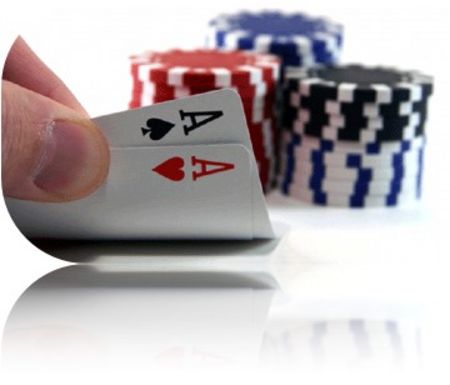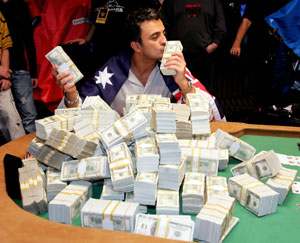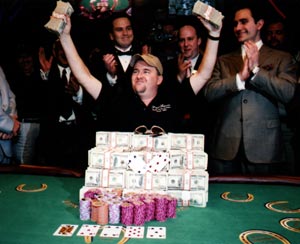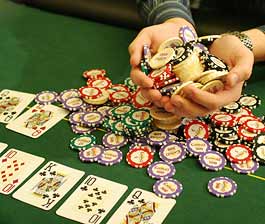Starting Hands Advanced Concepts

Advanced concepts that may allow you to play a few more
hands than recommended in the previous chapter. In addition, we discuss
situations where you might add a little deception to your game. Most of these plays
are borderline decisions that have an expected value of close to break even or are
just slightly profitable for advanced players. Beginning players will probably lose
money playing these additional bands; therefore. I recommend that beginning
players skip this chapter until they have gained more experience and feel confident
in all other aspects of the game.
A lot of the value in these plays is the advertising value of giving yourself a looser
image to cam more profits later when you hold strong hands; however, I don't
recommend plays just to boost your image unless you can at least break even on
the play, especially on the Internet.
Internet Tip
Table image is not as important online
as it is in live games. Players do not stay in one game very long on the Internet and tend not to pay
as much attention to the game; therefore, strategies that aim to create or take advantage of table
image are generally not as profitable online as they would be in a live game. Of course, you can still
use your table image online in the right circumstances, especially at some of the smaller sites where
you play often against regular opponents. At larger sites like Party Poker, table image is less
important since players are constantly moving in and out of games.
The plays discussed in this chapter are not necessarily for everybody. Some
players are successful with a very tight strategy while others are successful with
looser strategies playing every single borderline hand. Neither strategy is better
than the other one is. Both players may win close to the same amount of money in
the long run. although the player who plays more of the borderline hands will have
larger fluctuations in his bankroll. This is just a matter of your own personal style.
Early Position

Premium hands such as AA, KK, and AKs do not come along very often. You would
like to maximize your chances of winning a large pot with these hands if possible. If
you tire in a light game where there is a decent chance that all of your opponents
will fold if you raise, one strategy is to just call. If one of your opponents raises, you
can then go ahead and reraise. Of course, the risk in just calling is that a player
with a medium holding will play and hit something good on the flop.
I like to mix up my play by sometimes calling and sometimes raising, depending on
how my opponents might perceive my play. If I have been playing a lot of hands, I
would probably go ahead and raise since my opponents may not respect my raises
as much. If I have been playing very few hands, I would probably just call since I do
not want to raise and just win the blinds with these hands.
This strategy of only calling with premium hands should only be used in tight
aggressive games. In loose games, you should usually go ahead and raise since
you can expect to get some callers. Note that this strategy is most profitable from
early position. When you raise from middle or late position, your opponents will call
with more hands since they expect you to reduce your raising standards. Whenever
there is one caller in the pot, you should also go ahead and raise since now you
have at least one opponent to challenge you.
In tight games, you can consider raising first in with the medium pairs 77 and higher
and AJ. Hopefully, you can win the pot outright or at least get the pot heads up to
give you a good chance of winning the hand on the flop.
In the previous chapter, we discussed hands you could play once there was a
caller. Advanced players can usually play these hands first in unless the game is
very aggressive: A8s, A7s, KJs, and QJs. Axs is also a borderline hand playable
from early position in both loose and tight games.
In almost all games, the following hands are unprofitable from early position: AT,
KJ, KT, QJ, and QT.
Number of Callers
If you are playing in a loose passive game and there has already been one or two
callers, you can play a few more hands such as 66, 55, KTs, QTs, and JTs. An
additional caller benefits your hand in several ways:
-
You are getting better pot odds.
- The remaining players are more likely to call, improving your pot odds further
since they are getting better pot odds also. For example, most opponents will
fold 67s in middle or late position with only one caller, but against two callers
they might call.
-
When two players have called the pot, opponents are less likely to raise
behind you except with premium hands. For example, an opponent with AJ in
late position would probably only call against two opponents while he might
raise against one.
Even if the pot is raised behind you, at least there are several opponents playing to
give you better pot odds for your hand.
Raised Pots
You can either call or reraise with JJ or AQs depending on the circumstances. With
JJ, you should remise against a weak player in a tight game if you think you can
isolate him. Tend to only call if the game is loose.
When the pot has been raised, borderline hands include TT, AQ, AJs, ATs, and
KQs. Strategies with these hands are dependent on the type of opponent who
raised and the type of game. You could reraise with these hands against some
opponents, just call in a loose game, or possibly fold against a strong opponent in a
tight game.
Deceptive Plays
One play used by some advanced players is to raise occasionally with some of the
middle connectors such as 98s. One reason for this play is to ensure that you get
future action with your early position raises. If you only raise with AA, KK, QQ, and
AK, your more observant opponents will not call too often.
Internet Tip
This is an excellent example of a deceptive play that does not work very well on the Internet. In a
live game, this type of play might pay benefits for several weeks if you play against regular
opponents. On the Internet, you normally are playing against a lot of new opponents for a short time
period. In addition, if there isn't a showdown, most sites do not allow you to show your cards, so you
might not even be able to show your opponents the \"crazy\" play you made. Even if you do get to
show your hand, some opponents might not even notice if they are playing two tables or are
otherwise distracted.
Middle Position

Advanced players should consider raising first in with any hand that you would call
if you feel you have a reasonable chance of either stealing the blinds or con-trolling
the flop with a good table image. Some hands to consider raising first in include: 99,
88, 77, A9s, A8s, A7s, KQs, KQ, KJs, KTs, QJs, QTs, and JTs. Important
considerations in your decision include the type of game, what players are
remaining, your table image, your exact position, and the type of opponent in the
big blind.
Chances of success are better in seats seven or eight since you are closer to a
steal position. Although it is only one seat, some of these hands like QTs and JTs
should probably be folded from seat six, since there is a better chance that an
opponent has a premium hand behind you. These raises work best in tight games,
so it is probably best to just call if the game is loose or you have a loose player in
the blind.
If one opponent has already called, there are circumstances when you can still
raise the pot with borderline hands. The first thing you must determine is if you
would like to play a multi-handed pot or try to isolate. If you are in a tight game and
your raise could isolate yourself against the lone caller, raising might be correct if
your opponent is weak; the big blind is very light, your table image is very strong,
etc. Some hands to consider raising against one caller include JJ, TT, 99, AJ, ATs,
A9s, A8s, and A7s. Hands like QJs and JTs are best played in a multi-handed pot,
so I would just call.
Note that small pairs should be folded from middle position unless there are at least
a couple of callers. If there are no callers at this point, you are not getting sufficient
pot odds to draw to a set.
Raised Pots
Your first consideration in a raised pot is the position of the raiser. A raise from a
strong player in early position indicates a premium hand while a raise from seat
seven could be quite different. For example, many opponents will raise with KQs or
KQ from middle position but just call from early position: therefore, you can consider
reraising some hands against a middle position player that you probably should fold
against an early position player.
Hands to consider reraising against a lone middle position raiser include: JJ, TT,
99, AQs, AQ, AJs, and AJ. Against a strong opponent, consider folding TT, 99, and
AJ. Reraising an early position opponent with these hands is mostly dependent on
the type of opponent and those remaining behind you. AJ is a hand that you should
probably almost always fold against an early position player. KQs is usually
playable against a middle position raiser and is a borderline decision against an
early position raiser. Throughout a hand, always be aware of the position of the
raiser to help you determine his possible hands.
Late Position

You can raise first in with even more hands than discussed in the last chapter,
especially if the blinds are tight or play poorly after the flop. Your positional
advantage allows you to play even some weak hands profitably in certain situations.
Hands to consider raising include all pairs, any two cards 9 and higher, any two
suited 8 or higher, Ax, and Kxs. I f the blinds fold more than 50% of the time and
you have a strong table image, you could raise with even more hands.
Let's discuss how you can play QQ from late position. Of course, you should almost
always raise with this premium hand; however, sometimes you might just call when
there are three or tour callers already in the pot. Calling can be a good play for two
reasons, First, an ace or king will come on the flop 43% of the time, which is bad
news against so many callers. The more important reason is that you have a better
chance of driving out your opponents on a favorable flop by keeping the pot small.
With a raised pot, your opponents will be correct to draw to many hands on the flop.
If the pot is small, your bet or raise on the flop could drive out many of your
opponents giving you a better chance of winning if an ace or king comes on the turn
or river. You can still raise in this situation as either play is very close in regards to
profit expectation, but just calling can add a little deception to your game to confuse
your opponents.
Sometimes against one caller, raising is profitable even with average holdings such
as 99, 88, 77, AT, KQ, KJs, KJ, and QJs. You need to decide whether you prefer to
isolate yourself against the lone caller or play your hand against several players.
These types of raises depend on several factors. If your opponent is a solid player
from early position, you need to be selective in which hands you raise with.
Opponents who only call first in from middle or late position are generally indicating
weakness, as most opponents will raise with their strong hands; therefore, your
hand might be the best hand justifying a raise. In loose games where the blinds call
many raises, tend to call more since it is more difficult to isolate yourself against a
lone opponent.
Advanced players can call with a few more hands in late position than indicated in
the previous chapter. With one caller add K9s. With two callers you can usually play
K8s, K7s, JT, and 98s. You can also consider calling with the small pairs against
two opponents if they tend to play poorly after the flop.
With three callers you could add K6s, K5s, Q8s, J8s, T8s, 87s, and 76s. With four
or more callers you might even add a few more suited hands.
Raised Pots
The skill level and position of your opponent is very important when determining
strategy against raisers. A good guideline for advanced players is to either reraise a
lone opponent or fold. For example, hands like TT, AQ, and AJs and borderline
hands against raisers from early position, If you are going to play, you should
generally reraise to use your positional advantage. Against a late raiser you can
almost always reraise.
Against a lone raiser from seat eight or nine, advanced players can reraise with
more hands if the conditions are right. Many players are trying to steal the blinds
from this position, so you can reraise to try and use your positional advantage to
take control of the hand. Against tight players, you still should only play the
premium hands. Hands to consider reraising include all pairs, Axs, AJ, AT, A9, A8,
KQ, KJs, KJ, and even QJ.
Note that QJ is not a real strong hand; however, if you can get this hand heads up,
you have a couple of ways to win the pot. If a queen or jack flops, of coarse you are
happy and can bet. If an ace or king flops, there is a decent chance your opponent
will fold against this scare card; therefore, you can safely bet the flop with any A, K,
Q, or J. If you are called with an ace or king on the flop, you should probably back
off your hand on the turn since your opponent has probably hit a pair.
Deceptive Plays
If you are playing against strong players who play well after the flop, you might
consider raising medium pairs when there are already at least three callers in the
pot. This raise gains you two things. When you hit your set, your opponents are
getting proper pot odds to draw to two pair, so you will get better action. If you don't
hit your set, sometimes all the players will check to you and you can take a free
card for that slim chance of hitting your set on the turn. These types of raises do not
gain a lot against weak players since they will be chasing on the flop in any case
without good pot odds. In this case, it is best to just call for a small price to see if
you hit your set.
NEXT The Blinds

